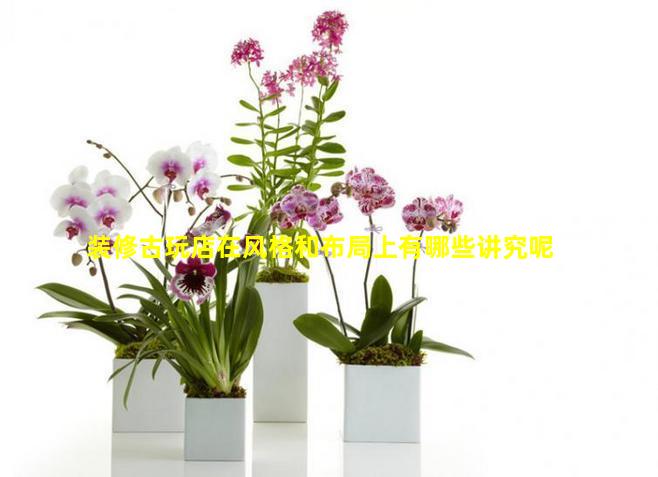装修古玩店在风格和布局上有哪些讲究呢
- 作者: 朱梓昂
- 来源: 投稿
- 2024-11-03
1、装修古玩店在风格和布局上有哪些讲究呢
风格讲究:传统中式风格:沉稳大气,以红木家具、古玩瓷器为主,营造典雅尊贵的氛围。
现代中式风格:融合现代元素,既有传统韵味又兼具时尚感,适合年轻消费者。
日式风格:简洁雅致,注重空间利用,以自然元素和原木家具为主。
欧罗巴风格:奢华贵气,以水晶吊灯、皮革沙发、欧式雕刻家具为特色。
混搭风格:自由创意,将不同风格元素融合,打造独特的店铺氛围。
布局讲究:1. 空间规划:
分区明确:将古玩店划分为展示区、交谈区、办公区等。
动线流畅:确保顾客可以在店铺中顺畅浏览,避免拥挤混乱。
2. 展示陈列:精品展示:用灯光、支架等手段突出重点古玩,吸引顾客目光。
类别分组:根据古玩的类型、年代、风格进行分组展示,方便顾客查找。
层次分明:利用不同高度的展示柜和陈列架,打造丰富的视觉效果。
3. 照明设计:自然光利用:利用大窗户或天窗引入自然光,营造明亮宽敞的氛围。
灯光布置:根据展品特点选用暖光或冷光,营造合适的观赏环境。
重点照明:用聚光灯突出展品的精致细节,吸引顾客驻足。
4. 环境布置:背景装饰:使用中国画、书法、竹石等元素,营造文化氛围。
音乐播放:选择轻柔雅致的音乐,烘托古朴静谧的氛围。
香氛营造:点燃沉香或檀香,增添舒适放松的体验。
5. 细节考究:标牌清晰:注明古玩的年代、产地、价格等信息,方便顾客了解。
防盗措施:安装警报器、摄像头等安防设备,确保古玩安全。
专业导购:配备专业导购员,为顾客提供知识讲解和购买建议。
2、装修古玩店在风格和布局上有哪些讲究呢图片
风格:复古典雅:营造出怀旧优雅的氛围,使用实木家具、古董装饰、复古墙纸或地毯。
现代简约:采用简洁明快的线条,强调空间感和采光,使用现代家具和艺术品。
东方风情:融入东方元素,如中式屏风、日式榻榻米、东南亚风格的编织工艺品。
工业风:注重实用性和工业元素,使用裸露的砖墙、金属管件和复古灯具。
波西米亚风:混合多种文化和风格,以鲜艳的色彩、异域风情的图案和独特的摆设为特色。
布局:合理分区:将古玩店划分为不同区域,如陈列区、销售区、储藏区和接待区。
陈列方式:利用橱柜、展示架和吊灯等方式陈列古玩,突出其特色和价值。
动线设计:确保客户在店内的移动顺畅,避免拥挤和迷路。
采光和照明:利用自然光和人工照明营造良好的光线环境,突出古玩的细节和美感。
通风和温度控制:保证古玩店的通风条件,防止湿度和霉菌,并控制温度以保护脆弱的物品。
图片示例:[图片1:复古典雅风格的古玩店,实木家具和古董装饰营造出温馨的怀旧气息。]()
[图片2:现代简约风格的古玩店,简洁的线条和现代艺术品营造出清爽雅致的空间。]()
[图片3:东方风情风格的古玩店,中式屏风和日式榻榻米营造出东方文化的韵味。]()
[图片4:工业风风格的古玩店,裸露的砖墙和金属管件营造出粗犷不羁的氛围。]()
[图片5:波西米亚风风格的古玩店,鲜艳的色彩和异域风情的图案创造出自由奔放的空间。]()

3、装修古玩店在风格和布局上有哪些讲究呢英文
When decorating an antique shop, there are several considerations to make regarding style and layout.
1. Cohesive Style
The overall style of your antique shop should be cohesive and reflect the types of antiques you sell. For example, if you specialize in Victorian antiques, your shop should have a Victorianinspired aesthetic. This can be achieved through the use of dark wood furniture, rich fabrics, and antique light fixtures.
2. Balanced Layout
The layout of your antique shop should be balanced and easy to navigate. Avoid cluttering your shop with too many items, as this can make it difficult for customers to browse. Instead, use a variety of display techniques to create a visually appealing space. For example, you can use shelves, cabinets, and tables to display your antiques.
3. Focal Points
Create focal points throughout your antique shop to draw customers' attention to specific items. This can be done by using lighting, color, or display techniques. For example, you can use a spotlight to highlight a particularly rare or valuable item.
4. Ambiance
The ambiance of your antique shop should be inviting and comfortable. Use soft lighting to create a warm and welcoming atmosphere. You can also play soft music in the background to create a relaxing ambiance.
5. Customer Service
Good customer service is essential for any retail business, including antique shops. Make sure your staff is knowledgeable about the antiques you sell and is able to answer customers' questions. You should also be willing to negotiate prices and offer discounts to loyal customers.
4、装修古玩店在风格和布局上有哪些讲究呢英语
Antiques Shop Decor: Style and Layout Considerations
The ambiance of an antiques shop plays a crucial role in the overall customer experience. The style and layout should evoke a sense of history and nostalgia, while still being wellorganized and inviting. Here are some key considerations to keep in mind when designing the space:
Style:Vintage Chic: Showcase antiques alongside modern pieces for a contemporary yet timeless atmosphere.
Traditional: Opt for classic furnishings and traditional décor to maintain a sense of authenticity.
Eclectic: Combine different eras and styles for a unique and eclectic vibe.
Industrial: Exposed brick walls, metal accents, and vintage industrial furniture create a raw and edgy atmosphere.
Layout:Flow and Circulation: Ensure a smooth flow of traffic throughout the shop. Create designated areas for browsing, displays, and checkout.
Lighting: Use a combination of natural and artificial lighting to highlight antiques and create a warm and inviting ambiance.
Displays: Design showcases and displays that complement the style of the shop and showcase antiques in the best possible light.
Focal Points: Create focal points in the shop by grouping eyecatching pieces together or highlighting unique finds.
Rest Areas: Provide comfortable seating areas for customers to relax and appreciate the antiques.
Clutter Control: Keep the shop wellorganized and free of excessive clutter to maintain a sophisticated and professional atmosphere.
Additional Tips:
Incorporate historic or antique elements into the décor, such as old photos, maps, or architectural fragments.
Use vintage display cases and furniture to enhance the authenticity of the space.
Create a scent that evokes a sense of nostalgia and invites customers to linger.
Offer complimentary amenities like magnifying glasses or guidebooks to enhance the customer experience.
Consider hosting themed events or talks related to antiques and collecting.
